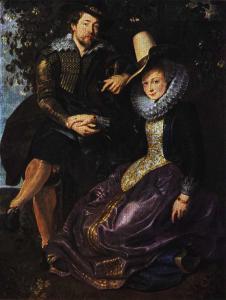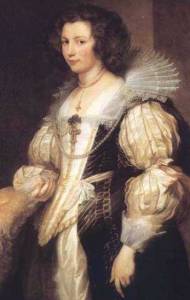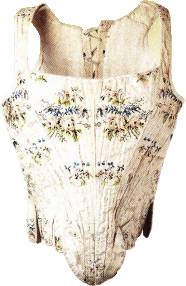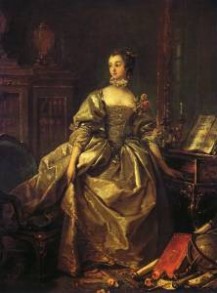Things tighten up - Baroque period (17th Century)
The period of early Baroque shows a wide range of national differences in ladies court-fashion. In countries under the influence of the house of Habsburg, the corset remained very stiff up to the middle of the century, but lighter material was used (preferably whalebone) and the manufacturing technologies improved significantly. In addition, a little bit more space for the breasts was given. The hoop-skirts now were barrel-shaped (this style came from France) and had a circumference up to 5 metres.

In other European countries more easy-going dresses with a lot of lace were fashionable. Hoop skirts had fallen out of favour, instead, bolsters on the hips were used. France became, based on its absolutist monarchy and the splendid royal court, the leading nation in any respect on questions of fashion. Corsets were used for tight-lacing now, especially in France. To get the expected straight front, a rod, made of wood or metal (or sometimes a dagger), was inserted into a vertical pocket of the corset, just in front of the breastbone.
If the matter became too uncomfortable (for instance at an opulent dinner - very polular in baroque) this rod could be taken out. Such a part was named in German 'Blankscheit' (= 'shiny rod'), which became "Planchette" in French. This French word is still in use today and describes a strong rod of stiff spring steel underneath the front busk hooks and eyes of a corset (not needed for every corset, but only if enhanced stiffness of the front is needed).

Balls and Mistresses - The Period of Rococo (18th Century)
The word ‘Rococo’ is the modified French word ‘Rocaille’ and describes a playful, shell-shaped decoration on buildings. Nearly everything was more ‘easy’ and playful now.
 |
The corsets, too, ceased to have a straight front and were used to show all parts of the female torso in the best light. The absolutist monarchy and its display of splendour reached its summit (which preceded its end). Corsets manufactured in this period were mostly sophisticated, expensive masterpieces. To get the expected stiffness, a large number of relatively thin whalebones (sometimes up to 100 pieces) had been sewn in. |
Valuable fabrics were used as outer material and corsets became sometimes part of the outer garment. The design called for shoulder-straps and the hip-part was made in such a way that a smooth transition to the again fashionable hoop-skirts was achieved. The new types of hoop-skirts (different styles during the rococo, the 'panier'-style being the best-known) had sometimes really ‘royal’ dimensions, up to 7 metres circumference. The tightly-laced waist appeared unbelievably small in them.
| The corset of a distinguished lady was laced at the rear in general, because she had her maid constantly available. Front busk-hooks (in the design of today) were not available, so for each dressing of her ladyship the whole lace had to be threaded and laced. Common people made do with more simple and less expensive stays without supporting whalebones, and lacking a maid, with front-lacing. Many national or regional costumes have their origin in these times. |
Revolution and Napoleon - the Period of Empire (1789 - 1815)
The absolutist monarchy in France had overstepped the mark. The French revolution broke out and ended in the declaration of the republic. The guillotine decapitated the Royal Family, including the famous tight-lacer Queen Marie-Antoinette. Everything which had something to do with aristocracy was tabooed. That included corsets, too.





